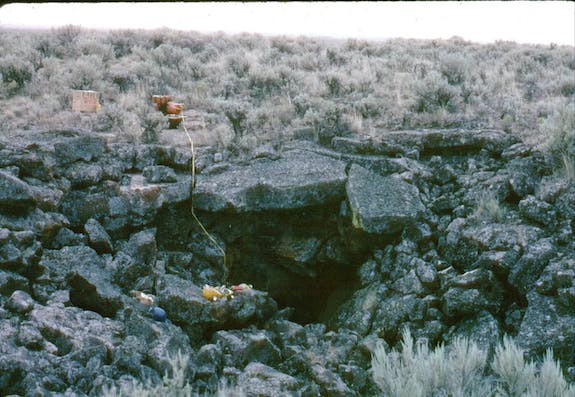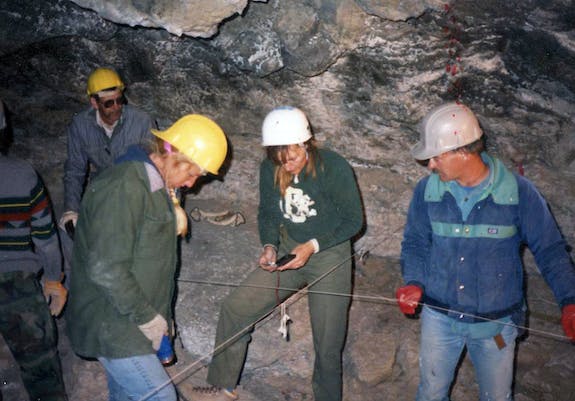About 40 years ago, a spelunker named Tom Miller discovered a cave near eastern Idaho’s Big Southern Butte containing a mystery unlike any previously found on the Snake River Plain.
In addition to the desiccated remains of a bobcat and her kittens, Bobcat Cave contained signs of use by Native Americans: red ochre “tally marks” on the cave walls, and stone tools and other artifacts scattered across the floor.
Strangest of all, the deepest part of the cave — the location with the highest concentration of artifacts — was frigid. Little did Miller know, beneath a few inches of dirt, clues to how ancestors of the Shoshone and Bannock Tribes survived the lean times in this challenging landscape lay frozen in solid ice.
Miller contacted the Bureau of Land Management (BLM), the agency that manages the land where Bobcat Cave is located. The BLM archaeologist, in turn, called in a team from Idaho State University (ISU) for a dig that took place in 1987. Among the ISU team was graduate student Lael “Suzann” Henrikson, who now works in Idaho National Laboratory’s Cultural Resource Management Office.
Henrikson recently published a paper in the Journal of Anthropological Archaeology suggesting that Native American use of similar caves coincided with hot, dry periods during the past 8,000 years.
Into the darkness
Bobcat Cave consists of two separate lava tubes connected by a narrow tunnel. Henrikson and her colleagues, who were wearing helmets and headlamps, had to scoot on their stomachs to get through.

While the first chamber is a relatively balmy 54 degrees Fahrenheit, the second, lower chamber hovers at a constant 34 F year round. The lower chamber was also completely devoid of light. “You cannot see your hand two inches in front of your face down there,” Henrikson said.
The archaeologists found the burnt ends of sagebrush torches shoved into the nooks and crannies of the cave, but wondered how Native Americans could use fire to see without filling the cave with smoke.
When the archaeologists lit their own fire in the lower chamber, the smoke escaped through the natural cracks in the basalt.
“As an archaeologist, that just gives you goose bumps because that’s a connection to the actual people who were using the cave,” Henrikson said. “That’s really the ultimate goal, to have a window into their lives.”
The elk antler tines and river cobbles presented another puzzle. “Some of the river cobbles had been used as tools,” Henrikson said. “We thought that was really weird. There’s not a river bed within 20 miles.”
Most of the antler tines were smashed on the fat end as if they had been repeatedly hit with a hammer.
“My professor and I could not figure out what in the world this site represented,” Henrikson said.
An even bigger mystery was why would people bother with Bobcat Cave at all? The cave was cold, hard to navigate, hard to find, pitch black and miles away from any permanent water source.
Answers in the ice
Henrikson and her colleagues decided to dig a 1×1 meter test pit into the frozen dirt in the lower chamber to see what they could find. “We started seeing the broken tips of the antler tines as the frozen deposits got more and more frozen,” Henrikson said. “We thought, ‘They’re coming down here and they’re harvesting ice.’”
A subsequent experiment with a fresh antler tine, a river cobble and a bucket of frozen water showed that elk antler tines make effective ice picks.
The archaeologists didn’t get very deep before they discovered a well-constructed, three-layered sagebrush feature frozen in the ice. Native Americans had burnt the tops of the sagebrush stalks and the roots, and they had layered them in rows.
Underneath the sagebrush feature they found clear ice, antler tines and bison bones. “All of the evidence suggests that bison parts were being dragged down there so they could be frozen,” she said.

Since the 1987 dig in Bobcat Cave, Henrikson has found six additional caves on the Snake River Plain that once served as meat caches for the ancestors of the Shoshone and Bannock. The people who used these caves probably made the sagebrush mats to disguise the smell of the meat from scavengers.
Analyzing artifacts
Radiocarbon dating puts the Bobcat Cave cache at around 4,100 years old, but dates from the other caves – Tomcat Cave, Scaredy Cat Cave, Fortress Cave, Wolffang Cave and Bearpaw Cave – range from roughly 8,200 years ago to about 950 years ago.
And while the caves were used periodically throughout those roughly 7,000 years, they were not used constantly. Instead, the radiocarbon dates clustered during certain timeframes. In other words, Native Americans cached bison meat only during certain years, even though these caves likely have remained cold enough to freeze meat all the time.
Archaeologists think that one of the reasons why people stored food was to cope with shortages caused by environmental variability. Storing food reduces the risk during lean times when prey is not readily available.
In her original research at Bobcat Cave, Henrikson came up with the idea that Native Americans only stored bison meat in the cold caves when the climate was hot and dry. “Bison love those cool season grasses and they need water,” Henrikson said. “When it got hotter and drier, bison were few and far between.”
This hypothesis was based on existing climate models at the time. According to those models, the Snake River Plain was experiencing a hot, dry phase when Bobcat Cave was being used. If the models were correct, bison populations on the Snake River Plain would have been greatly reduced during this time.
Investigating a hot, dry climate
Years later, armed with evidence from multiple caves, Henrikson used more refined climate models of the Holocene era to confirm a relationship between climate, bison abundance and cold storage.
In fact, radiocarbon dates from all of the caves appear to coincide with dry periods predicted by an archaeoclimatic model that relies on factors such as glacier volume and volcanic aerosol production to make predictions about Holocene weather patterns.
Henrikson and her colleague, Dr. David Byers, a Utah State University professor, sought to further confirm these models by comparing the ratio of the heavy isotopes of carbon found in bison bone from the cold storage caves.
If the value of the carbon isotopes indicated that bison were consuming a diet consisting predominantly of C3 grasses — grasses that thrive in cool, wet temperatures — the Snake River Plain was experiencing a cool, wet period.
Instead, Byers and Henrikson found carbon isotope values indicating a diet of C4 grasses, which are more common in hot, dry conditions.
Likewise, the relative abundance of two oxygen isotopes found in the bison bone from the caves shows that these animals were drinking warmer water, also indicating a hotter, drier climate.
“During these warm, dry periods, the precipitation on the Snake River plain would have been significantly lower, and there wouldn’t have been the density of grasses that bison need,” Henrikson said.
“The Snake River Plain is marginal bison territory anyway,” she continued. “If there isn’t water in the ephemeral ponds and those cool season grasses aren’t growing, the bison are going to be extremely scarce.”
But the Native Americans who made the Snake River Plain their territory found a way to adapt, using ice in the lava tubes to preserve a precious resource.
The seasonal round of the ancestral Shoshone and Bannock
The oral traditions of the Shoshone and Bannock describe a yearly circuit that included much of the Snake River Plain and surrounding regions. Today, the Tribes continue to maintain the traditions of hunting and gathering in the areas used for thousands of years.

Based on the evidence from the cold storage caves, these sites were part of the seasonal round and important to small, extended family groups who traveled across their territory each year to gather sufficient resources to survive, according to Henrikson.
The landscape was challenging, especially during hot, dry years when bison were hard to find. They traveled on foot, and they hunted by funneling bison into draws formed in the basalt pressure ridges of the Snake River Plain.
Once the animals were trapped, the hunters likely killed two or three of them with atlatls, a type of dart thrown using a stick with a cup or notch at one end for leverage, similar to how a modern-day lacrosse player throws a ball using a lacrosse stick.
“They would encounter a small group of bison and dispatch a few of them and put them in cold storage because they didn’t know when they would encounter bison again,” she said. “They carried bison meat to these caches and came back for it in the springtime, only removing what they needed.”
The process of hauling the bison meat, river cobbles and antler tines to the cave, fracturing the ice and building the sagebrush mat likely involved a huge amount of labor, which explains why the caves were likely used only when bison were scarce.
When the climate was cool and moist and bison were plentiful, the ancestral Shoshone and Bannock probably didn’t bother with the cold storage caves.
Nevertheless, the caves’ locations were likely handed down from generation to generation, and perhaps periodically used as a source of water.
“I have the utmost respect for Native American populations that could make a living out here,” Henrikson said. “These locations are passed down through elders for thousands of years. It’s their lifeline. You have to know where the resources are on the landscape when you need them.”





